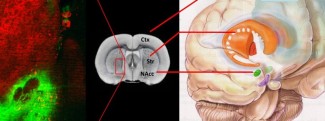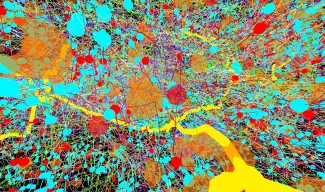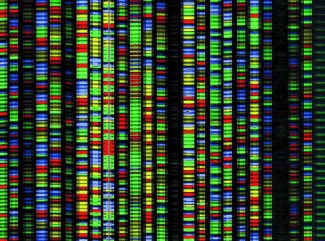The Biotechnology & Biotherapy team, created by Dr. Jacques Mallet and presently directed by Dr. Philippe Ravassard, at Paris Brain Institute, in collaboration with the Pole of Therapeutic Innovation in Neuropsychiatry at the Servier Research Institute, has highlighted a new therapeutic target for the treatment of schizophrenia. It is about a new receptor called “Gpr88” – a protein present on cell surface – and localized exclusively in the brain. Authors show that local inactivation of “Gpr88” normalizes some behaviors altered in a model of schizophrenia. These behaviors are refractory to the current therapies utilized in humans. This work, conducted by Manuela Ingallinesi for her Ph.D. thesis under the scientific direction of Dr. Rolando Meloni, constitutes an important breakthrough in the validation of Gpr88 as a novel therapeutic target as well as an innovative experimental approach for the treatment of schizophrenia. This study has been published August 26th 2014 in Molecular Psychiatry one of the leading journals in psychiatric research.
Schizophrenia, characterized by “positive”, “negative” and “cognitive” symptoms, is a serious and handicapping mental illness affecting about 1% of the population. The current therapies are essentially based on neuroleptics that allow for managing “positive” symptoms such as delusions and hallucinations, as well as “negative” symptoms such as blunted affect and lack of emotions, but are less effective against “cognitive” deficits, characterized by disorganized thinking. Moreover, up to one third of the patients do not respond to these therapies. Therefore, new therapeutic targets are actively sought for improving the treatment of schizophrenia symptoms, particularly cognitive deficits.
“Gpr88” is a receptor (a protein present on cell surface) with an unknown role that is expressed almost exclusively in the Striatum, a brain structure deeply implicated in neuropsychiatric diseases. The interest of the Biotechnology and Biotherapy team for Gpr88 stems from the work of Drs Meloni and Mallet in psychiatric genetic showing that the gene coding for Gpr88 is associated as a risk factor with schizophrenia. To address the biological basis of this association, Dr. Meloni and his collaborators have assessed the role of Gpr88 using a rat model of schizophrenia.
The researchers show that local inactivation of this protein in the Nucleus Accumbens (a brain structure, localized in the ventral part of the Striatum, whose function is deeply altered in the course of schizophrenia) significantly reduces the behavioral alterations associated to the schizophrenia model. Notably, a normal behavior in a social cognition test is reestablished by the inactivation of Gpr88 in the Nucleus Accumbens.
These results, which have just been published in the scientific review Molecular Psychiatry, show that Gpr88 is a novel potential therapeutic target of great interest for the treatment of schizophrenia. It is for the Institut du Cerveau - ICM and its researchers a new hope for the development of novel treatments that may take care of the cognitive deficits refractory to the currently used drugs.

Sources
Ingallinesi et al., Local inactivation of Gpr88 in the Nucleus Accumbens attenuates behavioral deficits elicited by the neonatal administration of phencyclidine, Molecular Psychiatry (online publication, 26 August 2014)






